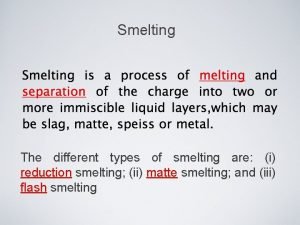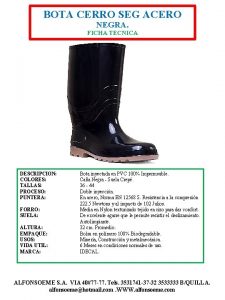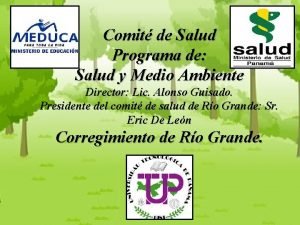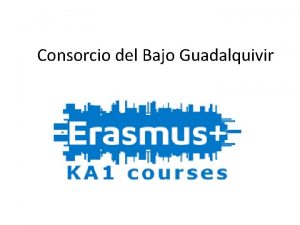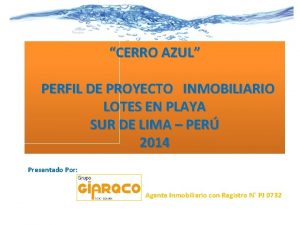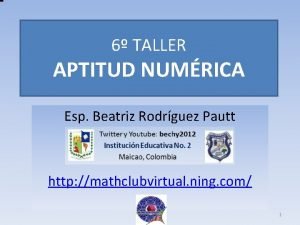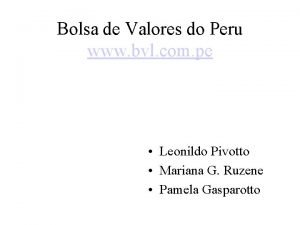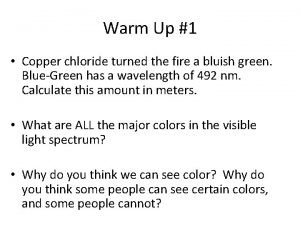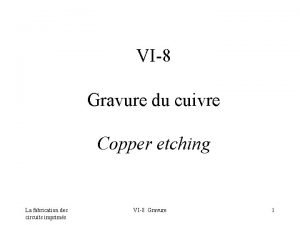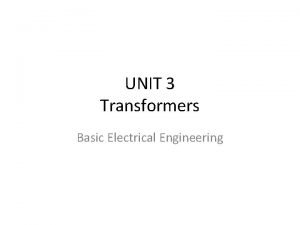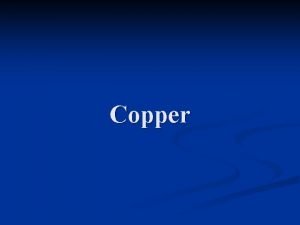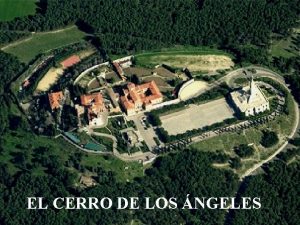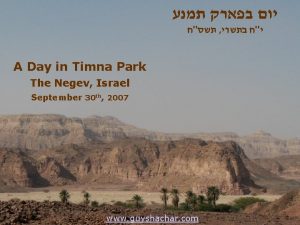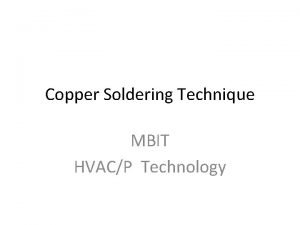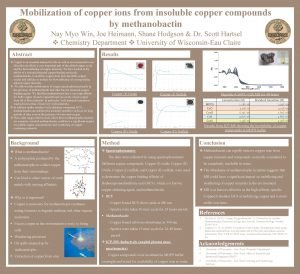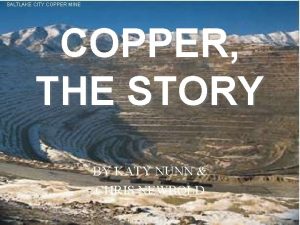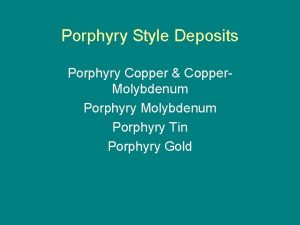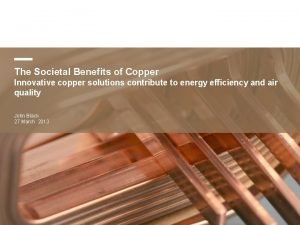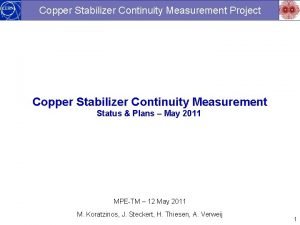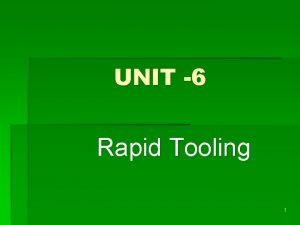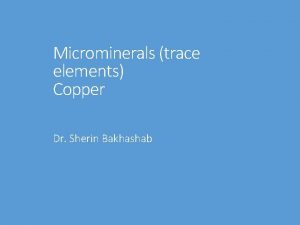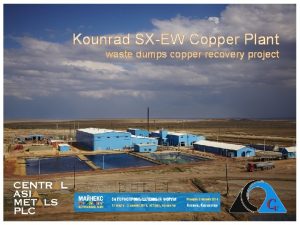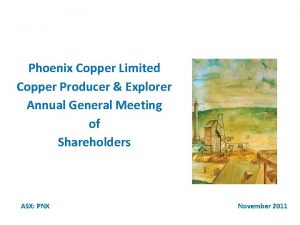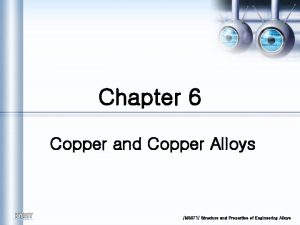Ancient Copper Smelting at Timna Cerro Huaringa Analysis



















- Slides: 19

Ancient Copper Smelting at Timna & Cerro Huaringa Analysis & Comparison of Two Copper Smelting Experiments

Smelting vs Melting § Melting involves high temps to liquify a solid § Smelting also involves high temps. However, it is more of a chemical process that involves more than just heat.

Copper’s Discovery § Its usefullness was probably first discovered as Stones Age Tool Makers realized certain rocks did not respond to hammerblows by flaking or fracturing, but rather remained intact and changed shape, thus its discovery. § Copper is believed to have been the first metal to have been smelted during the 6 th millennium B. C. E. in Anatolia (Catal Huyuk)

The Process of Smelting § Smelting involves extracting the metal from its ore.

The Recipe to Smelt Copper Ingredients: • Ore • Charcoal • Flux Preheat your furnace to 1200 celsius. Grind and dry your ore. Place a “charge” of ore and flux into furnace. Blow air into furnace. “Tap” the furnace to extract molten slag from base of furnace. Allow to harden, then either shatter the slag or separate it from the copper that forms on the bottom.

What results from smelting? § Hopefully a useful amount of copper. § Slag! Slag is a byproduct of the smelting process that contains the undesired impurities

Timna, Israel

Batán Grande Region of Peru

Objectives of Timna Experiments § What were the maximum achievable temps in the furnaces? § What was the shape and quality of the smelted copper? § Additional questions: 1) Fuel Consumption 2) Copper Yields 3) Slag Volumes

Types of Experiments at Timna § 1) 2) 3) Simulated Done primarily in lab Used a furnace composed of modern materials Reconstruction Also done primarily in lab One experiment conducted on site at Timna Used a furnace composed of more authentic materials

Two Types of Furnaces @ Timna

Results of Individual Timna Experiments § Each of the 32 experiments had a different objectives § Examples: 1. They were able to reproduce the viscosity and amounts of slag found at Timna 2. Demostrated that large slag circles found at Timna must have been formed from a single slag tapping cycle

Conclusions of Timna Experiments § 200 mm distance from the tuyere to furnace bottom was found to be close to original. § Using a pot bellows with 1 inclined tuyere could have produced results found at Sites 2 & 30 § Furnaces did not reach a steady state mode of operation. Technical heat balances were not easily controlled in antiquity § Black copper (copper & iron)was usually the end product which needed further refining after smelting to produce a more purified form of copper


Objectives of Experiments at Batán Grande § “Figure out how the furnaces actually performed and how much labor was required to operate them. ”

Batán-Chungo Set

Tuyeres § Ceramic Tips that were attached to the ends of blow tubes. They were often decorated by Sican Metallurgists but not by later Chimu and Inca.

Results of Batán Grande Experiments § They created a lump of slag with same composition as those produced by Sican, Chimus & Incas. § Demonstrated their technology was relatively primitive & labor intensive § Each smelting required 4 to 5 hours § Experimenters estimated that 300 kilos of charcoal were used daily § Each smelting would have produced 0. 3 to 0. 5 kilograms of metallic copper

The End Sican Smelting Furnace
 Hollywood silver fox farm v emmett
Hollywood silver fox farm v emmett Different types of smelters
Different types of smelters Ceip virgen del cerro
Ceip virgen del cerro Bota cerro
Bota cerro Cerro guacamaya
Cerro guacamaya Ceper cerro macareno
Ceper cerro macareno Proyecto cerro azul
Proyecto cerro azul Tres muchachos están escalando un cerro
Tres muchachos están escalando un cerro Bvl cerro verde
Bvl cerro verde Ancient communication devices
Ancient communication devices Ancient india vs ancient china
Ancient india vs ancient china The rime of the ancient mariner shmoop
The rime of the ancient mariner shmoop The rime of the ancient mariner analysis line by line
The rime of the ancient mariner analysis line by line The rime of the ancient mariner part 3
The rime of the ancient mariner part 3 Ancient gesture
Ancient gesture All in a hot and copper sky the bloody sun at noon
All in a hot and copper sky the bloody sun at noon Figurative language in copper sun
Figurative language in copper sun Copper chloride fire
Copper chloride fire Fournisseur chlorure cuivrique
Fournisseur chlorure cuivrique Efficiency of transformer formula
Efficiency of transformer formula

